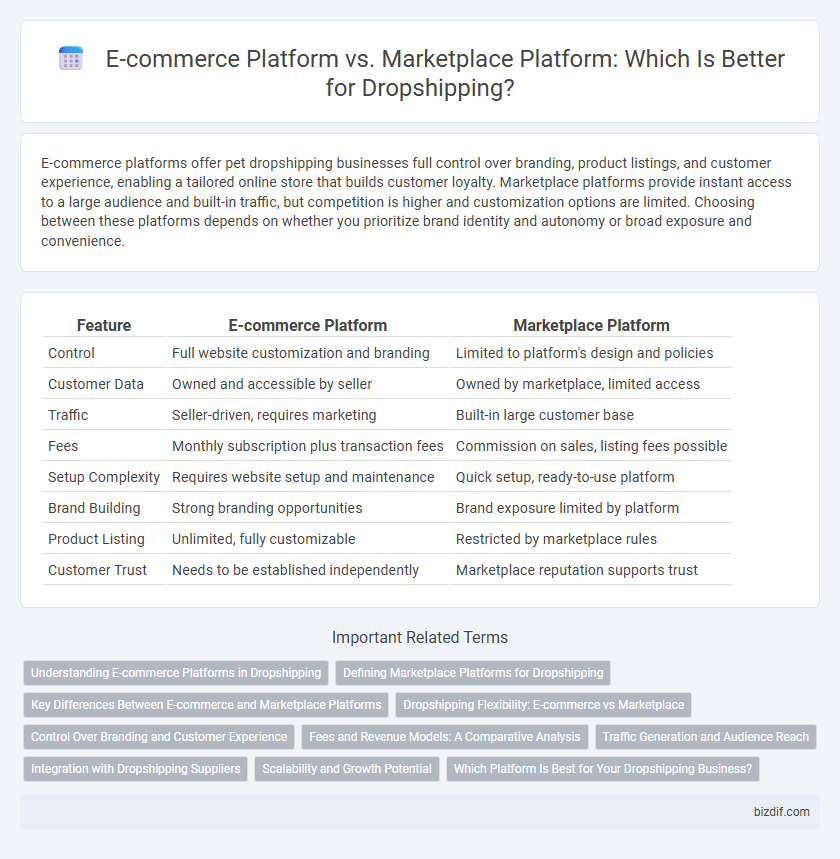E-commerce platforms offer pet dropshipping businesses full control over branding, product listings, and customer experience, enabling a tailored online store that builds customer loyalty. Marketplace platforms provide instant access to a large audience and built-in traffic, but competition is higher and customization options are limited. Choosing between these platforms depends on whether you prioritize brand identity and autonomy or broad exposure and convenience.
Table of Comparison
| Feature | E-commerce Platform | Marketplace Platform |
|---|---|---|
| Control | Full website customization and branding | Limited to platform's design and policies |
| Customer Data | Owned and accessible by seller | Owned by marketplace, limited access |
| Traffic | Seller-driven, requires marketing | Built-in large customer base |
| Fees | Monthly subscription plus transaction fees | Commission on sales, listing fees possible |
| Setup Complexity | Requires website setup and maintenance | Quick setup, ready-to-use platform |
| Brand Building | Strong branding opportunities | Brand exposure limited by platform |
| Product Listing | Unlimited, fully customizable | Restricted by marketplace rules |
| Customer Trust | Needs to be established independently | Marketplace reputation supports trust |
Understanding E-commerce Platforms in Dropshipping
E-commerce platforms like Shopify and WooCommerce provide dropshippers with customizable websites, enabling complete control over branding, product listings, and customer experience. These platforms support seamless integration with dropshipping apps such as Oberlo and Spocket, automating order fulfillment and inventory management. Utilizing an e-commerce platform enhances scalability and direct customer interaction, distinguishing it from marketplace models like Amazon or eBay.
Defining Marketplace Platforms for Dropshipping
Marketplace platforms for dropshipping serve as online intermediaries connecting multiple sellers with a broad customer base, enabling seamless transactions without direct inventory management by the platform owner. These platforms, such as Amazon, eBay, and AliExpress, provide integrated tools for product listing, payment processing, and customer service, streamlining operations for dropshippers. By leveraging existing traffic and trust, marketplace platforms offer dropshippers scalable solutions to reach diverse markets while minimizing upfront costs and logistical complexities.
Key Differences Between E-commerce and Marketplace Platforms
E-commerce platforms allow businesses to create their own branded online stores with full control over product selection, pricing, and customer experience, offering greater customization and branding opportunities. Marketplace platforms aggregate multiple sellers under one digital roof, facilitating increased product variety and customer reach but with limited control over individual storefronts and often higher competition. The key differences hinge on ownership of customer data, control over marketing strategies, and revenue models, as e-commerce platforms typically generate income through sales and subscriptions, while marketplaces earn via commissions and listing fees.
Dropshipping Flexibility: E-commerce vs Marketplace
E-commerce platforms offer greater dropshipping flexibility by allowing full control over product selection, pricing, and branding, enabling seamless integration with various suppliers and automation tools. Marketplace platforms provide access to a large customer base but limit customization options and often impose rules that restrict dropshipping practices. Choosing an e-commerce platform like Shopify or WooCommerce enhances dropshipping scalability and brand identity compared to marketplaces such as Amazon or eBay.
Control Over Branding and Customer Experience
E-commerce platforms like Shopify and WooCommerce provide full control over branding, allowing dropshippers to customize store design, customer journey, and communication channels to create a unique brand identity. Marketplace platforms such as Amazon and eBay offer limited branding opportunities since the customer experience is standardized and dominated by the marketplace's interface and policies. This lack of control can reduce a dropshipper's ability to differentiate their products and build long-term customer loyalty.
Fees and Revenue Models: A Comparative Analysis
E-commerce platforms typically charge subscription fees and transaction fees, offering sellers control over pricing and branding, while marketplace platforms operate on commission-based models, taking a percentage of each sale. Marketplace fees can range from 5% to 20%, affecting profit margins, whereas e-commerce platforms often incur fixed monthly costs regardless of sales volume. Choosing between these models depends on factors like expected sales, budget for upfront fees, and desired level of autonomy in managing the online store.
Traffic Generation and Audience Reach
E-commerce platforms like Shopify enable dropshippers to build customized stores, providing control over branding and direct customer engagement, which fosters organic traffic growth through SEO and targeted marketing campaigns. In contrast, marketplace platforms such as Amazon or eBay offer instant access to vast, pre-existing audiences, accelerating sales but with increased competition and limited control over customer data. Effective traffic generation on an e-commerce platform relies on consistent content marketing and social media strategies, whereas marketplaces depend heavily on internal algorithms and paid advertising for audience reach.
Integration with Dropshipping Suppliers
E-commerce platforms like Shopify and WooCommerce offer seamless integration with dropshipping suppliers through dedicated apps and plugins, enabling automated order processing and inventory management. Marketplace platforms such as Amazon and eBay provide a broader customer base but often limit direct integration, requiring manual coordination with suppliers. Choosing an e-commerce platform facilitates better control over branding and supplier connections, enhancing operational efficiency in dropshipping.
Scalability and Growth Potential
E-commerce platforms offer greater scalability and growth potential by providing full control over branding, customer experience, and marketing strategies, enabling businesses to expand product offerings and optimize sales channels efficiently. Marketplace platforms limit scalability due to shared customer bases and restricted control over pricing and promotions but provide immediate access to a large audience, facilitating initial growth. For dropshipping entrepreneurs aiming for long-term growth, e-commerce platforms present more opportunities to scale operations, integrate advanced tools, and build a sustainable brand presence.
Which Platform Is Best for Your Dropshipping Business?
Choosing between an e-commerce platform like Shopify and a marketplace platform such as Amazon depends on your dropshipping business goals and control preferences. E-commerce platforms offer greater customization, brand building, and direct customer relationship management, while marketplace platforms provide instant access to high traffic, built-in customer trust, and streamlined order processing. Evaluating factors like marketing control, scalability, fees, and target audience helps determine which platform best aligns with your dropshipping strategy.
E-commerce Platform vs Marketplace Platform Infographic

 bizdif.com
bizdif.com